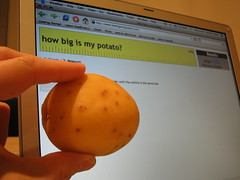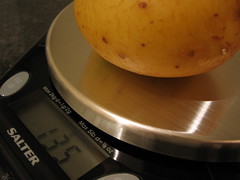World’s largest potato would take 131 minutes to cook in a microwave (maybe)
Literally more than 5 people have directed me to the news about the discovery of the world’s largest potato. Everyone wants to know the reaction from the world’s premier website dedicated to personal potato measurement.
I have read a few of the news reports, but it seems very unlikely that Colin and Donna Craig-Brown are aware of howbigismypotato.com, and it seems even less likely that they would have used it to measure their prized specimen, equipped as they are with physical measuring devices. Therefore the best I can do is to imagine what it would be like to measure “Doug” online. It’s quite easy to reverse-engineer the size of an imaginary potato of the same mass. See this screenshot:
Note the smooth shape of the virtual potato (the original photo still shows the reference potato purchased from Sainsbury’s 15 years ago) which is very different to the “characterful” shape of potato being simulated. This is a limitation of the currently available technology. While the record-breaking mass of the real potato is well known from news reports, nobody seems to have written about how long it would take to cook in a microwave. You’ll see straight away from the screenshot that we have an estimate: 131 minutes and 31 seconds.
I have to stress that no serious effort has ever been made to properly calibrate these cooking times, especially at the wild extremes being explored here. It’s important not to rely on the results for anything safety critical. If you experience a disappointingly raw potato, or melt your microwave, please don’t hold me responsible.




